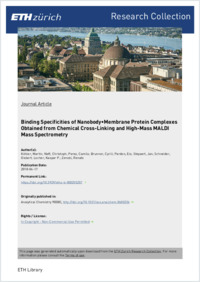Binding Specificities of Nanobody•Membrane Protein Complexes Obtained from Chemical Cross-Linking and High-Mass MALDI Mass Spectrometry.
- Köhler M Department of Chemistry and Applied Biosciences , ETH Zürich , Vladimir-Prelog-Weg 3 , 8093 Zurich , Switzerland.
- Neff C Department of Chemistry and Applied Biosciences , ETH Zürich , Vladimir-Prelog-Weg 3 , 8093 Zurich , Switzerland.
- Perez C Institute of Molecular Biology and Biophysics , ETH Zürich , Otto-Stern-Weg 5 , 8093 Zurich , Switzerland.
- Brunner C Department of Chemistry and Applied Biosciences , ETH Zürich , Vladimir-Prelog-Weg 3 , 8093 Zurich , Switzerland.
- Pardon E Department of Chemistry and Applied Biosciences , ETH Zürich , Vladimir-Prelog-Weg 3 , 8093 Zurich , Switzerland.
- Steyaert J Institute of Molecular Biology and Biophysics , ETH Zürich , Otto-Stern-Weg 5 , 8093 Zurich , Switzerland.
- Schneider G Department of Chemistry and Applied Biosciences , ETH Zürich , Vladimir-Prelog-Weg 3 , 8093 Zurich , Switzerland.
- Locher KP
- Zenobi R
- 2018-03-22
Published in:
- Analytical chemistry. - 2018
Campylobacter jejuni
Cross-Linking Reagents
Crystallography, X-Ray
Membrane Proteins
Models, Molecular
Nanostructures
Spectrometry, Mass, Matrix-Assisted Laser Desorption-Ionization
English
The application of nanobodies as binding partners for structure stabilization in protein X-ray crystallography is taking an increasingly important role in structural biology. However, the addition of nanobodies to the crystallization matrices might complicate the optimization of the crystallization process, which is why analytical techniques to screen and characterize suitable nanobodies are useful. Here, we show how chemical cross-linking combined with high-mass matrix-assisted laser/desorption ionization mass spectrometry can be employed as a fast screening technique to determine binding specificities of intact nanobody•membrane protein complexes. Titration series were performed to rank the binding affinity of the interacting nanobodies. To validate the mass spectrometry data, microscale thermophoresis was used, which showed binding affinities of the stronger binding nanobodies, in the low μM range. In addition, mass spectrometry provides access to the stoichiometry of the complexes formed, which enables the definition of conditions under which homogeneous complex states are present in solution. Conformational changes of the membrane protein were investigated and competitive binding experiments were used to delimit the interaction sites of the nanobodies, which is in agreement with crystal structures obtained. The results show the diversity of specifically binding nanobodies in terms of binding affinity, stoichiometry, and binding site, which illustrates the need for an analytical screening approach.
- Language
-
- English
- Open access status
- green
- Identifiers
-
- DOI 10.1021/acs.analchem.8b00236
- PMID 29562137
- Persistent URL
- https://folia.unifr.ch/global/documents/31347
Statistics
Document views: 17
File downloads:
- Full-text: 0
